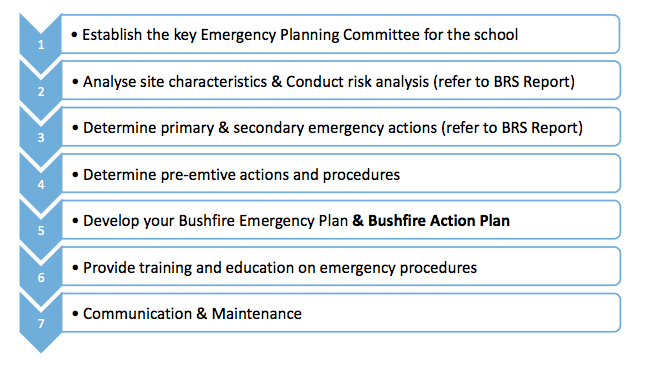School emergency management - overview
Bushfire Planning: Overview
Bushfire Emergency Planning must account for the complexity and variability of bushfire threat, and therefore requires a tailored planning approach that includes careful consideration of factors such as the nature of the hazard, building and occupant vulnerability, emergency options analysis, and contingency planning.
It is through appropriate emergency planning considerations of risk analysis with a range of bushfire scenarios that will inform the range of procedures to varying bushfire conditions. This process will assist in identifying primary, secondary and pre-emptive actions in the bushfire emergency plan.
A Bushfire Emergency Plan is a written set of instructions that details what occupants and visitors to a site should do in preparation, response, and following a bushfire emergency. The plan document should clearly state what actions are to occur, when and how; including the roles and responsibilities of relevant school staff, and the emergency triggers and response actions the school will activate in the event of a bushfire threat.
Bushfire knowledge and an understanding bushfire behaviour in relation to weather, the TFS Bushfire Alert Levels, Fire Danger Ratings, and Bureau of Meteorology Fire Weather forecasts, other warnings and observations will frame your planning. The Bushfire: Prepare Act Survive part of TFS website will assist in broadening your bushfire knowledge.
What’s involved?
The planning process is a sequence of steps which will result in:
- A definition of the purpose of the plan;
- A definition and understanding of roles and responsibilities;
- Clear control and coordination arrangements; and
- A simple written plan
The development of an effective Bushfire Plan relies on the following planning process:

Bushfires are a part of the Tasmanian landscape
Depending on the geographic location and surrounding environment some schools are at higher risk of bushfire than others. In the event of a bushfire, preparation, planning and emergency coordination is required for the safety of staff, students and visitors.
Most education facilities already have emergency plans to facilitate the safe movement of staff, students and visitors in the case of an evacuation. These procedures usually involve occupants evacuating buildings to an outdoor assembly point on the facility grounds; such as in the case of an internal or building fire.
In the event of a bushfire however these procedures may not be appropriate or adequately address the safety of staff and students. For instance evacuating to an outdoor assembly point on-site is not ideal in the case of bushfire as it exposes staff and students to potential heat, smoke and embers. Schools in high bushfire risk areas require emergency planning adapted to the unique characteristics of bushfire threat for each school site.
Your school’s Bushfire Ready Schools (BRS) Bushfire Assessment Report categorises the school site, as per the Tasmania Fire Service Bushfire-Ready Schools categories, and provides suggestions for bushfire protection measures against radiant heat, direct flame contact and ember attack.
The Determination and Notes part of the report may assist your school’s emergency planning process by making clear reference to specific hazards to the schools buildings.
Schools that have not been assessed should plan as a BRS Category 2 school- buildings may not be safe to shelter in during the passage of the main fire front.
Click here for more about BRS school categories and assessment.
Schools that are a BRS Category Low school should use their department’s general emergency planning guidelines as the school is considered inherently bushfire safe due to separation distance from nearest bushfire hazard.
For a BRS assessment for your school contact planning@fire.tas.gov.au





